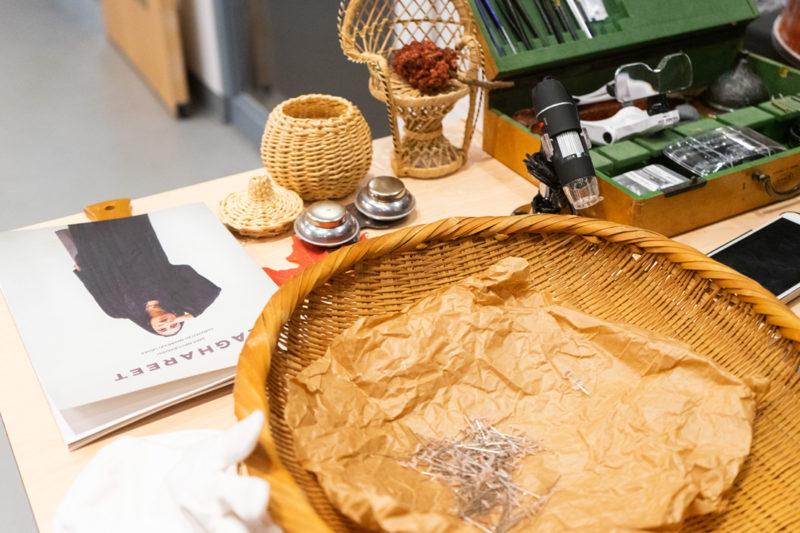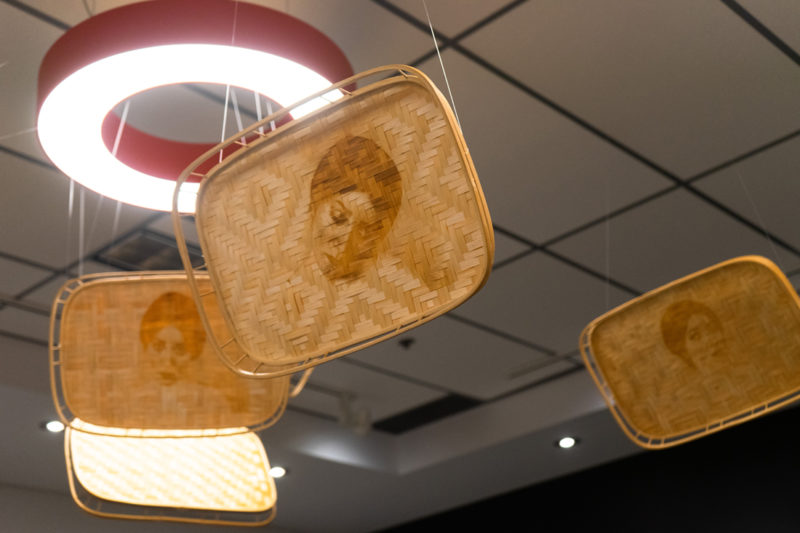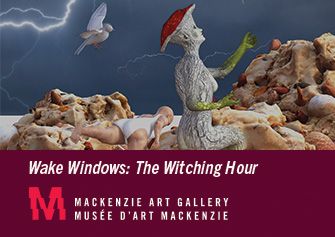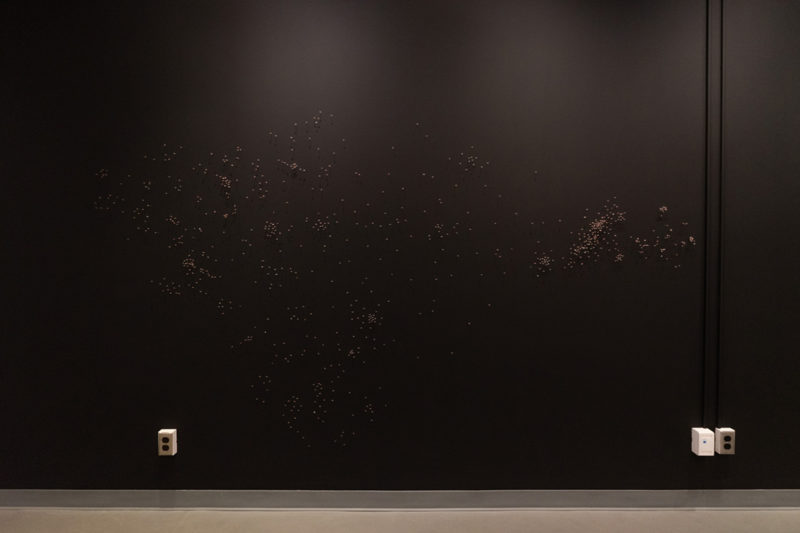I, Saffron
18 October 2020By Margaryta Golovchenko

A warm sensation arises inside of me as I step into the Joan Goldfarb Visual Arts Study Centre. Originally a storage space for artwork that has recently been converted into a small gallery as part of a pilot project, the space is small and cozy. The gallery is well-lit by large circular lights hanging from the ceiling, the light warm and soothing as opposed to glaring in the way white cube galleries sometimes are. There is an interplay between black and white in the space, the exterior wall on the left-hand side of the gallery is painted a matte black that instantly draws the eye. A rug on the floor and the comfortable-looking couch just off to the side serve as an invitation to linger, adding a sense of intimacy to the space.
This sense of welcome and relaxation, so often associated with domestic spaces, is the focus of Sara Niroobakhsh’s exhibition I, Saffron. Part of the curatorial series We Are Here, which “explore[s] the concepts of ‘here’ and ‘there’” and considers the ways “‘We are here’ is ultimately a statement of affirmation,” (1) Niroobakhsh describes I, Saffron as “a performance piece that reflects the workings and poetics of Persian cuisine, […as] [c]ooking saffron rice is a creative art that can be interpreted as theatrics.” (2) Whether in the familiar contrast of private and public, or the gendering of space, or the more abstract and often internal space where one goes to reconnect with their cultural heritage, this question of relationality is palpable as soon as you enter the gallery, lingering as one moves through it.
The focal point of the exhibition is the piece Saffron Diary (2019), which also lends the exhibition its name. An “homage to all the female ancestors whose journey consisted of creating joy out of routine and ordinary practices,” (3) the work speaks to the loaded history of personal diaries, particularly those kept by women. Scholars like Valerie Raoul have long pointed out the way, in the West, personal diaries (journal intime) were considered to be an appropriate form of writing for women, who “were discouraged from writing for the public.” (4) It is only more recently that scholarship has emerged about the role diaries played for women in late 19th and early 20th century Iran, revealing striking results. (5)
During all my visits back to the exhibition, I never once managed to catch Niroobakhsh engaged in the performance aspect of the exhibition, sitting at the table just left of the entrance—to see the toolkit open and the artist peeking into the micro lens of her camera as she used a brush made of strands of her hair dipped in saffron ink to inscribe tiny words onto grains of rice, creating a miniscule diary. I was only able to encounter the aftermath, the leftover traces of Niroobakhsh’s presence in the form of the final product. The whiteness of the grains of rice gradually created a constellation-like form that spilled across the dark expanse of the wall, their red script hidden from me behind the double-layered barrier of language and scale, as if the words were protecting the meaning from prying eyes. It felt as if Niroobakhsh was playing with the viewer, acknowledging the innate curiosity we often feel when we find out that someone we know well keeps a private diary in plain sight. What makes Niroobakhsh’s work unique is the miniscule size of the grains of rice, making it difficult to even make out what is inscribed, to say nothing of the language barrier for some visitors. The grain of rice became a kind of punctum that carried me through the exhibition, watching it transition from this physical form—captured within a glass hourglass and small globes—to a snow-like frozen blur in the photo documentation and video work. Even the empty sacks that hung in a back corner of the gallery became a designated “archive” where objects like shirts and historical photographs were displayed.

Spectacle is at the centre of I, Saffron. Despite the subject matter of the works—private activities which occur behind closed doors and away from the gaze of patriarchal society—ironically their functions as works of art instead both invites and expects viewership. The video work Rainfall (2015-19), which was originally performed in front of an audience, is particularly striking for this reason, as the monotony of routine tasks that Niroobakhsh comments on now exists as an endless video loop that is performed to no one and everyone simultaneously, the quiet pattering of the rice against the tray filling the space with a ghost-like echo. Unlike Saffron Diary (2019), where the repetitiveness of Niroobakhsh’s actions speaks to a persistence to tell one’s story and the calmness that can sometimes be found in repetition, Rainfall instead addresses a sense of heaviness, particularly when one performs the action out of an enforced sense of duty.
Niroobakhsh’s work captures the tension between internal desire and external appearance, as the need to hide one’s emotions and put on a performance is characteristic of practices of hospitality, which the piece The Party (2017) comments on. Consisting of numerous woven baskets, or rattan, each has the image of Niroobakhsh laser printed into it, literally transforming woman into object, permanently linking the two. It is unsettling to realize that the images on the trays will fade, having already lost fidelity since their creation in 2017. This gradual disappearance of Niroobakhsh’s image signals once again to the invisibility of the female body in domestic spaces, as well as to the need to constantly adhere to the accepted and gendered social codes as embodiments of hospitality.

I, Saffron takes up the call expressed by Linda Nochlin in her famous essay “Why Have There Been No Great Women Artists?,” where Nochlin asserts that “the problem lies not so much with some feminists’ concept of what femininity is, but rather with their misconception […] of what art is: with the naïve idea that art is the direct, personal expression of individual emotional experience, a translation of personal life into visual terms.” (6) Niroobakhsh emphasizes collectivity and knowledge systems that are often dismissed as tedious work and therefore hidden away, written off as something mundane and mechanical, like the process of sifting through rice. That is not to say that Niroobakhsh imbues the grain of rice with a kind of quasi-magical force that transforms it into an art object. Rather, rice serves as the bridge between domestic life and the art world, bridging the gap between the two by reminding us that questions of affect and emotional labour overlap in these two seemingly different worlds.
And while the invitation to sit, take off one’s shoes, and stand on the rug under the hanging rattans conveys a sense of welcome into the space, the two rows of burlap sacks lying on the floor feel like a quiet form of resistance—against the emotional and physical labour that women perform, against the perception that their thoughts and feelings should remain hidden, against the historically patriarchal perception that they have nothing to say that might be worthy of listening to, of being passed down. I, Saffron reimagines not only what women’s art and feminist art look like, but also considers the connection between personal and public by invoking the seemingly intimate spaces of the home and the pages of a private diary. The result is a grey zone in which the conversation about habitation and visibility is carried out on a microscopically nuanced level, proving to be anything but simple.
- Exhibition text for “I, Saffron,” 2019
- Artist website, statement on I, Saffron, http://www.saraniroo.com/saffrondiary#0
- Ibid.
- Valerie Raoul, “Women and Diaries: Gender and Genre,” Mosaic: An Interdisciplinary Critical Journal 22, no. 3 (1989): 58.
- See https://www.cbc.ca/radio/ideas/century-old-journals-reveal-iranian-women-s-quiet-resistance-1.5161754
- Linda Nochlin, “Why Have There Been No Great Women Artists?” in Women, Art, and Power and Other Essays (New York: Harper and Row, 1988), 149.
I, Saffron ran from September 5 – December 6, 2019 at the Joan Goldfarb Visual Arts Study Centre at York University in Toronto, ON.
Feature Image: Rainfall, 2014 by Sara Niroobakhsh. Photo by Meagan Veneracion courtesy of the artist.




